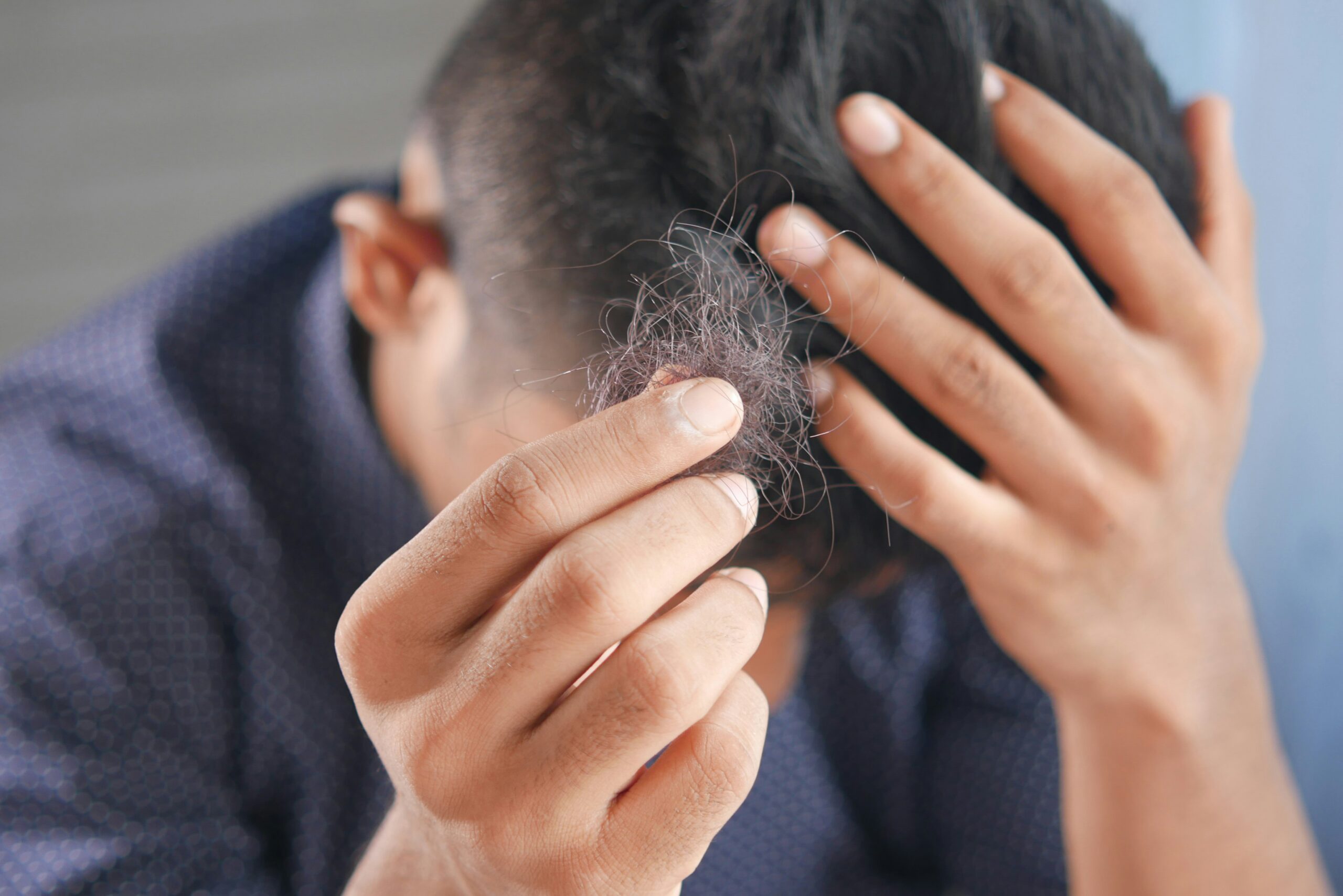🔎 What Is Male Pattern Baldness?
Male Pattern Baldness (MPB), or androgenetic alopecia, is the most common form of hair loss in men. It typically starts at the temples or crown and gradually progresses into a horseshoe pattern of thinning. Over 50% of men will experience MPB by age 50.

🤷 Why Does It Happen?
The root cause is genetics + hormones:
- Testosterone is converted to DHT (dihydrotestosterone).
- DHT causes hair follicles to shrink, shortening the hair growth cycle.
- Over time, follicles stop producing visible hair.
Why Are Men Aged 20–30 Experiencing Male Pattern Baldness?
The brutal truth:
Male pattern baldness in men as young as their 20s isn’t some fluke — it’s a genetic and hormonal ticking time bomb.
Here’s why it hits early for some:
- Genetics: If your family tree has early balding, you’re genetically wired for it. Your hair follicles are more sensitive to DHT from a young age.
- DHT Sensitivity: Some men’s hair follicles freak out at even normal levels of DHT. This sensitivity triggers follicle shrinkage and hair thinning fast.
- Hormonal Changes: Testosterone and DHT levels peak in early adulthood (20s–30s). For those genetically vulnerable, this means the battleground starts early.
- Lifestyle Factors: Stress, poor diet, and certain environmental triggers can accelerate the process, but they’re the fuel, not the fire.
📊 Research Evidence:
- Sawaya ME, Price VH. “Different levels of 5alpha-reductase type I and II in scalp of men and women with androgenetic alopecia.” J Invest Dermatol, 1997.
- Kaufman et al. (1999): DHT is the primary trigger for MPB in genetically susceptible individuals.
✅ Proven Treatments for MPB
1. Finasteride (Propecia)
Blocks 5-alpha reductase enzyme, reducing DHT levels.
🌐 Research:
- Kaufman et al. (1999): 1mg Finasteride slowed hair loss and improved growth in 80–90% of men.
- 5-Year Study (2002): Long-term use maintained or improved hair in 90% of users.
→ JAAD & European Journal of Dermatology
🚨 Side Effects (2–4%):
- Reduced libido, ED, depression (usually reversible).
2. Minoxidil (Rogaine)
Topical vasodilator that increases blood flow and stimulates follicles.
🌐 Research:
- Olsen et al. (2002): 5% Minoxidil significantly regrew hair at the vertex.
- Meta-analysis (2019): 5% is more effective than 2% for both men and women.
→ Dermatologic Therapy
ℹ️ Use:
- Apply once or twice daily to thinning areas.
- Results in 3–6 months.
3. Microneedling
Creates micro-injuries to stimulate collagen and enhance topical absorption.
🌐 Research:
- Dhurat et al. (2013): Microneedling + Minoxidil led to 4x more regrowth vs. Minoxidil alone.
→ International Journal of Trichology
ℹ️ Use:
- Weekly with a 1.5mm derma roller.
4. DHT-Blocking Shampoos
Shampoos with ingredients like ketoconazole, saw palmetto, or caffeine.
🌐 Research:
- Reagan-Shaw et al. (2011): Ketoconazole shampoo showed mild anti-DHT properties.
→ Journal of Dermatology
ℹ️ Use:
- 2–3 times per week for scalp health and to complement other treatments.
🌟 Supporting Factors: Lifestyle & Diet
- Sleep: Poor sleep raises cortisol, inhibiting hair growth.
- Nutrition: Ensure adequate levels of zinc, iron, biotin, and vitamin D.
- Stress: Chronic stress alters hormone levels and restricts scalp blood flow.
📅 Routine Summary Table
| Step | What to Do | Frequency |
|---|---|---|
| 1 | Finasteride 1mg | Daily |
| 2 | Minoxidil 5% | 1–2x Daily |
| 3 | Microneedling (1.5mm) | Weekly |
| 4 | Ketoconazole Shampoo | 2–3x Weekly |
| 5 | Sleep + Nutrition + Stress | Always |
🧠 Frequently Asked Questions (FAQs)
Do DHT Blockers and Supplements Affect Testosterone Levels in Men Aged 20–30?
Short answer: Most DHT blockers and supplements don’t significantly lower testosterone — some even cause a slight increase.
The truth:
- Finasteride blocks the conversion of testosterone to DHT by inhibiting the enzyme 5α-reductase. This means less DHT, but testosterone levels often rise slightly because less is converted away.
- Supplements like Saw Palmetto and Pumpkin Seed Oil mildly inhibit DHT production but have minimal to no impact on overall testosterone. They’re gentle but less powerful than prescription meds.
- These treatments target DHT specifically, not testosterone itself, so your total testosterone remains mostly stable.
For men aged 20–30, this means you can reduce harmful DHT effects on hair follicles without tanking your testosterone levels or your masculinity.
Q: Is MPB reversible?
- Not fully. You can slow or partially reverse it with early, consistent treatment.
Q: Should I start treatment even with mild hair loss?
- Yes. Earlier intervention leads to better outcomes.
Q: Is Finasteride safe long-term?
- Yes, according to long-term trials. But discuss with a doctor to understand risks.
Q: Can I regrow hair at the hairline?
- It’s harder than crown regrowth, but combination therapy (e.g., Minoxidil + Microneedling) may help.
Q: What happens if I stop treatment?
- Hair loss typically resumes and can accelerate. Think of these treatments as maintenance.
Q: Are hair transplants better?
- They work but are costly, invasive, and don’t stop future hair loss. Often used with medication.
⚡ Final Thoughts
Hair loss is personal — and emotional. Whether you choose to fight it or embrace the shave, the key is control. Understand your options, take action early, and stay consistent.

